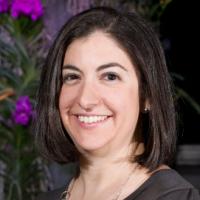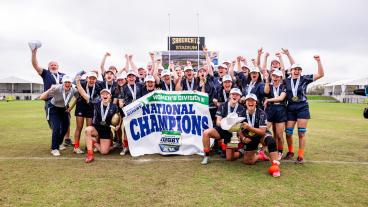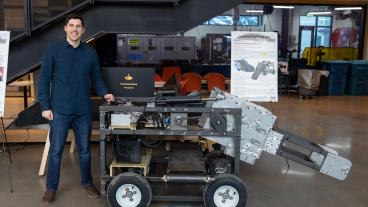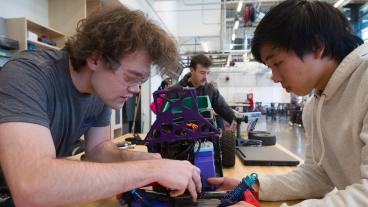How Colorado School of Mines grads succeed in aerospace careers – without an aerospace engineering degree
Orediggers are blazing trails in aerospace, using skills and experiences gained at Mines to land jobs in the industry
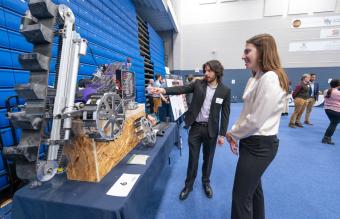
Mines students in Capstone Design showcase the mining robot they created to take part in NASA's Lunabotics competition. Capstone Design – the year-long creative, client-driven design experience that all mechanical engineering students participate in before graduation – regularly features aerospace projects among the options students can choose from.
If you think an aerospace engineering degree is necessary to pursue a career in the aerospace industry, think again.
Colorado School of Mines alumni are routinely sought out by and hired into the industry, despite Mines not offering a dedicated bachelor’s degree in aerospace engineering. In fact, about a quarter of Mines’ mechanical engineering graduates go into aerospace, said Daniel Blood, the department’s director of undergraduate studies.
“Aerospace is a specialized focus in mechanical engineering,” Blood said. “In the long term, having a mechanical engineering degree allows you to move around. You have a broader education and flexibility down the road. Having that ability means you have the skill sets to move to different roles and you have more options as you go forward. The industry can change, and your priorities could as well. Your skill sets won’t become obsolete.”
The formula for why Mines alums are so successful in aerospace is simple, Blood said: one part strong curriculum, another part industry connections, with a generous splash of hands-on experiences and real-world projects.
And while there isn’t a dedicated aerospace major at Mines, there are plenty of ways for students to individualize and specialize their academic experience to prepare for a career among the stars.
Within the Department of Mechanical Engineering, aerospace is one of eight dedicated tracks that undergraduate students can choose from. Launched in 2022, tracks are a way for mechanical engineering students to gain advanced knowledge in a specific area without having to take additional courses.
Students can also go a step further and pursue an aerospace engineering minor, taking six courses, some of which were designed in partnership with industry. Both designations appear on a student’s transcript.
“You have more depth in the aerospace engineering minor than you would in the track, so you gain more of those skills, but you don’t have to necessarily declare the minor to be successful,” Blood said.
Outside Mechanical Engineering, another option for space-minded undergrads is to pursue an Area of Special Interest (ASI) in Space and Planetary Science and Engineering, which covers a diverse array of topics, including planetary science, astronomy, space physics, and the design of engineering systems for space exploration.
Capstone Design – the year-long creative, client-driven design experience that all mechanical engineering students participate in before graduation – also regularly features aerospace projects among the options students can choose from. In fact, the second-place award at the Spring 2024 Capstone Design Showcase went to a team that created a lunar rover for Lunabotics, NASA’s Robotic Mining Competition, a real-world hands-on aerospace experience.
Enhancing aerospace skills through extracurricular activities
In addition to dedicated coursework, students interested in aerospace have a multitude of extracurricular activities to choose from at Mines.

Getting hands-on experience, plus the opportunity to network and socialize, is why Parmida Mahdavi joined the Mines chapter of the American Institute of Aeronautics and Astronautics (AIAA). Last year, she served on the chapter’s board as secretary.
Mahdavi has always been fascinated by space and the planets and knew her future career had to incorporate that interest in some way. But hers hasn’t been a straight path to engineering – at one point, she considered becoming an astronaut dietician.
“I’m one of those rare cases where I’ve always known what I wanted to do since I was a little kid,” she said. “But I wasn’t sure what kind of space job I wanted to have.”
After touring Mines, Mahdavi enrolled as an engineering physics major. But the space dream was always there. After her first semester, she learned about the Area of Interest in Space and Planetary Science and Engineering, which allowed her to follow her interest in physics while also nurturing her love of space. Mahdavi reached out to Angel Abbud-Madrid, director of the Center for Space Resources at Mines, who discussed the ASI with her.
“He was very helpful and understanding and made sure that I was choosing the right track for what I wanted to do,” Mahdavi said.
Mahdavi came to Mines from Colorado Springs but is originally from Iran. She wanted to find a program where she wouldn’t feel like her perspective and experiences were ignored. At Mines, she’s found a place to fit in while pursuing her passions.
“One of the notable things that I’ve really enjoyed while being here, and I think a reason why other students come here, is the amount of networking opportunities,” Mahdavi said. “I was a COVID freshman, but I still was able to join the Mines chapter of AIAA online and meet people who were into aerospace. Also in my first year, I was able to participate in NASA’s BIG Idea Challenge with the Space Resources Program. I got to meet a lot of graduate students, who all came from a bunch of different backgrounds.”
Non-traditional paths to aerospace success
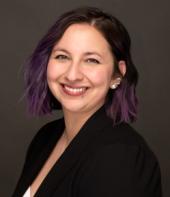
For Amanda Camarata, coming to Mines was exactly what she needed to get on the path to the aerospace industry.
Her first foray into higher education was at a large university in Texas, where a professor discouraged her from continuing her studies in engineering after she brought up that she was struggling.
Abandoning her engineering goals, she switched her major to sociology and graduated with a bachelor’s degree. But after 10 years of regretting that decision, she went to a Mines information session in Houston and was encouraged by what she learned.
“They really addressed some of the core concerns I had with going back into engineering, which was based around the whole reason why I left – it was hard and if I struggled, I wasn’t cut out for it,” she said.
But the Mines recruiters at the information session told her something she never heard at her first university – engineering is hard, but we’re here to support you.
“That was an a-ha moment for me, because I was so convinced up to that point that if I wasn’t getting it right away, I shouldn’t be an engineer,” she said. “That kind of reassurance that the struggle was normal and that there was a good support system was the reason I decided to come to Mines.”
With her focus back on aerospace, she decided to major in mechanical engineering at Mines and pursue the ASI in space and planetary science, like Mahdavi did. After completing her bachelor’s degree, she stayed on for her master’s degree in mechanical engineering, with a specialization in thermal fluids and energy systems.
“When I came to Mines, I had a better understanding of what being an aerospace engineer actually meant,” Camarata said. “To be an aerospace engineer, it’s just an engineer who works in aerospace. There are a few different majors that apply to that depending on the work you want to do.”
At first, coming back to school as a nontraditional student, Camarata wasn’t very involved in extracurriculars on campus. She wasn’t sure where she would fit in, being 10 years older than many of her classmates. But she decided that organizations focused on professional networking would be important, and she joined AIAA, eventually serving in several different board positions. She also led the planning for the Pathfinder Conference, an event designed to help high school and community college students from underrepresented groups realize their aerospace career dreams.
“I wanted to create something that allowed students to network and see what kinds of jobs they can pursue in aerospace,” Camarata said. “I wanted to dispel the myth that someone must be, like [NASA mathematician] Katherine Johnson smart to work in aerospace or a four-year degree is always necessary. Both of those can be true, but you don’t have to be or do that. You can go to trade school and be a welder for rockets or go to a community college and be a drafter. I wish I had known earlier that there are so many options.”
Camarata has felt confident in her decision to go to Mines and major in mechanical engineering instead of pigeonholing herself with an aerospace engineering degree.
“Many of the industry professionals I’ve talked to, they don’t actually hire many people with aerospace engineering degrees,” Camarata said. “Other degrees, like mechanical engineering, for example, are much broader. There are just so many things you can do as an engineer. I used to have a misconception that you need an aerospace engineering degree to go into that field. But knowing about all the different kinds of jobs that you can pursue in aerospace made it easier to know that yeah, I can do it.”
And she’s definitely been successful. Camarata graduated in May with her master’s degree and landed her first job in aerospace – today, she’s working as a thermal engineer for multinational aerospace company BAE Systems in Colorado.

